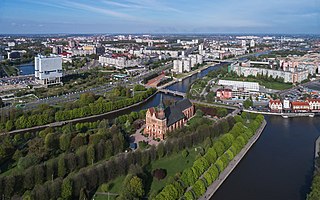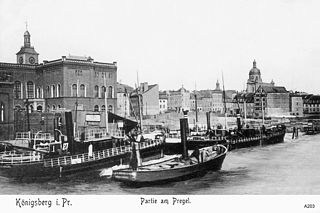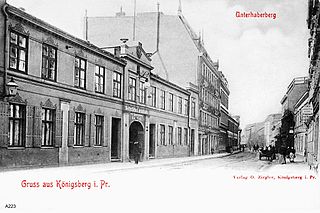
Kneiphof was a quarter of central Königsberg (Kaliningrad). During the Middle Ages it was one of the three towns that composed the city of Königsberg, the others being Altstadt and Löbenicht. The town was located on a 10-hectare (25-acre) island of the same name in the Pregel River and included Königsberg Cathedral and the original campus of the University of Königsberg. Its territory is now part of the Moskovsky District of Kaliningrad, Russia.

Löbenicht was a quarter of central Königsberg, Germany. During the Middle Ages it was the weakest of the three towns that composed the city of Königsberg, the others being Altstadt and Kneiphof. Its territory is now part of the Leningradsky District of Kaliningrad, Russia.

Altstadt was a quarter of central Königsberg, Prussia. During the Middle Ages it was the most powerful of the three towns that composed the city of Königsberg, the others being Löbenicht and Kneiphof. Its territory is now part of Kaliningrad, Russia.

The Lower Pond is a large artificial pond in northern Kaliningrad, Russia. It was known as the Schlossteich while part of Königsberg, Germany, until 1945.

Steindamm Church, St Nicholas' Church, or Polish Church, Old Lithuanian Church was the oldest church in the city formerly known as Königsberg, and today known as Kaliningrad, Russia.
A Freiheit was a quarter of medieval Königsberg, Prussia. All land surrounding Königsberg belonged to the Teutonic Knights, aside from specific tracts allocated to Königsberg's constituent towns or castle. The tracts, originally pastures and farmland, developed into suburbs subordinate in administrative, judicial, religious, and educational matters.

Vorstadt was a quarter of southern Königsberg, Germany. Its territory is now part of the Moskovsky District of Kaliningrad, Russia.

Haberberg was a mostly residential quarter of southern Königsberg, Germany. Its territory is now part of the Moskovsky District of Kaliningrad, Russia.

Neue Sorge, also known as Königstraße or Königstrasse after its main boulevard, was a quarter of eastern Königsberg, Germany. Its territory is now part of the Leningradsky District of Kaliningrad, Russia.
Sackheim was a quarter of eastern Königsberg, Germany. Its territory is now part of the Leningradsky District of Kaliningrad, Russia.

Burgfreiheit or Schlossfreiheit was a quarter of Königsberg, Germany. Its territory is now part of Kaliningrad, Russia.
Tragheim was a quarter of northern Königsberg, Germany. Its territory is now part of Kaliningrad, Russia.
Neurossgarten was a quarter of northwestern Königsberg, Germany. Its territory is now part of Kaliningrad, Russia.

Lastadie was a quarter of central Königsberg, Germany. Its territory is now part of Kaliningrad, Russia.

Lomse was a quarter of eastern Königsberg in Germany. Lomse was located on the western end of Lomse Island in the Pregel River; the large island is now known as October Island. The Neuer Pregel, the northern branch of the river, separated Lomse from Kneiphof to the west, Altstadt to the northwest, and Löbenicht to the north. Lomse's territory is now part of Kaliningrad's Moskovsky District and Lomse is now known as Oktyabrsky Island, in honor of the October Revolution.

Altrossgarten Church was a Protestant church in northeastern Königsberg. Johann Friedrich Schultz, an Enlightenment, Protestant, theologian, mathematician and philosopher was Deacon of the church in 1775.
Dalneye is a residential area in Moskovsky District of the city of Kaliningrad, Russia. It was formerly known by its German name Seligenfeld as first a suburb of and then a quarter of Königsberg, Germany, located southeast of the city center.
Nevskoye is a residential area in Leningradsky District of Kaliningrad, Russia. It was formerly known by its German language names Kummerau and Cummerau as first a suburb of and then a quarter of Königsberg, Germany, located northeast of the city center.
The Burgschule or Oberrealschule auf der Burg was a secondary school (Oberrealschule) located originally in central Königsberg, Germany, and later in the suburban Amalienau quarter. It was the fourth oldest school in the city, behind Altstadt Gymnasium, Kneiphof Gymnasium, and Löbenicht Realgymnasium.

The Collegium Fridericianum was a prestigious gymnasium in Königsberg, Prussia. Alumni were known as Friderizianer.



















